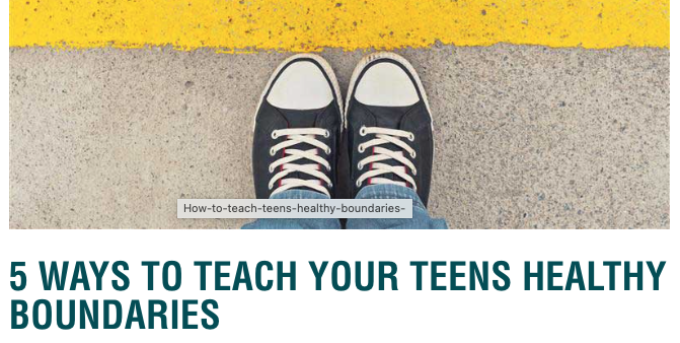
Boundaries
Skill-building
Setting boundaries involves defining our physical, emotional, and psychological limits and developing strategies for how to uphold them with ourselves and with others. Healthy boundaries help create healthy relationships. Boundaries are especially important when it comes to big feelings situations like grief and loss.
"Boundaries are rules, expectations, needs, and desires that help you feel safe and comfortable in life and in your relationships."
Nedra Glover Tawwab author of "Set Boundaries, Find Peace: A Guide to Reclaiming Yourself"
What's Ours vs. What's Theirs
We can’t control how someone else thinks, feels, or behaves. All we can control is what energy and behavior we allow into our lives and how we respond to it.
Boundaries are about taking responsibility for ourselves and our experience. Rather than telling someone else what they can or can't do, boundaries are our way of letting someone else know what we will and will not tolerate.
If someone says or does something that violates our boundaries, we can choose to communicate, set limits, and, if necessary, disengage.
Children, Teens, and Boundaries
Nedra Glover Tawwab, MSW, LCSW, author of Set Boundaries, Find Peace, discusses how we can set boundaries in our own lives and how we can cultivate the skill of boundary-setting in kids and teens.
Types of Boundaries
Boundaries can be:
Emotional
Emotional boundaries are about managing our feelings. They can include communicating preferences and limits related to the tone or language people use when speaking to us or which topics we are or or not open to discussing.
Intellectual
Intellectual boundaries are about managing our thoughts and ideas. They can include advocating for our own ideas while showing respect for others’ perspectives.
Material
Material boundaries are about managing our money and possessions. They can include communicating preferences and limits related to who we share our belongings with and under what terms.
Mental
Mental boundaries are about managing our thoughts and ideas. They can include limiting negative thoughts or self-talk and/or advocating for our own ideas while showing respect for others’ perspectives.
Physical
Physical boundaries are about managing our personal space and physical touch. They can include communicating preferences and limits related to how people engage with us physically and/or whether we choose to participate in certain activities.
Sexual
Sexual boundaries are about managing the emotional, intellectual and physical aspects of sexuality. They can include communicating preferences and limits related to sexual touch, activities, and/or comments.
Time-based
Time boundaries are about managing where/how we allocate our time. They can include determining how much time we give to different facets or our lives (work, relationships, hobbies).
It's normal and okay for boundaries to change. What feels good one day might not feel good another. You always have the right to determine your own boundaries.
Qualities of Boundaries
Boundaries can be:
Rigid
People with rigid boundaries might be thought of as guarded or detached. They typically avoid intimacy in close relationships, are unlikely to ask for help, have few close relationships, are secretive/very protective of personal information, and keep others at a distance to avoid the possibility of rejection.
Porous
People with porous boundaries are often considered "people-pleasers." They may overshares personal information, have difficulty saying “no," become over-involved with other people’s problems, depend on the opinions of others to form their own, accept of abuse or disrespect, and fear rejection if they do not comply with others.
Flexible (Healthy)
People with flexible (healthy) boundaries value their own opinion, don't compromise their values for others, share personal information in an appropriate way (not oversharing or under sharing), know their personal wants and needs AND communicate them, accept when others say “no” to them.
Establishing Boundaries
Being in touch with our emotions is the first step to determining our boundaries. Often if we feel angry, resentful, irritated, or anxious, it's an indication what a boundary has been violated.
- Reflect on the behavior that elicited this response and consider what we need to feel more comfortable. As we do this, consider the other person's unique identity, such as differences in values, experiences, and ability. It's important we realistically consider their ability to meet our need(s) because it may help us determine how to set our boundary.
- Separate our needs from their behavior. It's our responsibility to honor our needs. It's their responsibility to manage their emotions when we communicate our needs.
- Use clear language when we communicate our boundaries and expectations, making specific requests of their behavior.
- Decide what behavior we will use to enforce our boundary. For example, if someone ignores our boundary around when to call or visit, we can choose to not answer the phone or doorbell.
- It's normal for others to test our boundaries. It doesn't mean they are bad people, it's just human nature. Be prepared to communicate and enforce a boundary multiple times.
Identifying and communicating our boundaries can feel uncomfortable, especially if it's something we haven't done before. These are learnable skills that can become easier with practice.
Get Specific
Here are some examples of vague statements a kid or teen might make and an alternative, more specific version.
Many of us weren't taught about boundaries. It's common to feel uncomfortable, resistant, or even afraid as you learn how to establish, communicate, and uphold your boundaries. The more you do it, the easier it will be.
When you interact with the kids and teens in your life, remember to respect the boundaries they set for themselves.
Examples of Healthy Boundaries
Boundaries are unique to each person and each situation. Below are some examples of healthy boundaries:
- That is not something I am comfortable talking about.
- Thank you for inviting me to play. I need some time to myself today.
- I want to be a good friend to you and I feel like this is something you should talk to a grownup about.
- I don't want to give Uncle Bill a hug.
- If you keep yelling at me, I'm going to walk away.
- I feel uncomfortable talking behind that person's back. Let's talk about something else.
- I appreciate your concern. I don't want to share details about what happened.
- I feel unsafe when you touch me that way. I would appreciate it if you did not do it again.
- Those type of comments make me uncomfortable. Please do not talk about my appearance.
Although verbalizing our boundaries is not necessary to enforce them, knowing how to communicate our expectations is helpful.
People May Not Like Our Boundaries—And That's Okay
If someone is speaking to us in a tone we don't like, we might communicate a boundary around how we will and will not be spoken to. If they disregard our boundary and continue to speak to us in a way that doesn't feel good, we might choose to leave the situation.
They might be upset that we left—and that's okay. They are responsible for managing their feelings around us disengaging just as we are responsible for managing our feelings around their tone.
Remember, boundaries are about us. It is never our job to manage someone else’s emotions. That includes their reaction to our boundaries.
Sharing What You Know
You can help the kids and teens in your life learn to develop healthy boundaries by setting and maintaining them yourself. It's also important that you respect their boundaries. This can look like not forcing a child to give someone a hug if they don't want to or giving them the autonomy to accept or deny help rather than just jumping in.
Boundary Resources

Dr. Nedra Glover Tawwab - Free Worksheets
Description: Free worksheets from Dr. Nedra Glover Tawwaba therapist, boundaries expert, and author of Set Boundaries, Find Peace.
Source: Dr. Nedra Glover Tawwab

Five Ways to Teach Your Teens Healthy Boundaries
Description: It is important for teens to create and advocate for their own boundaries. By defining key personal preferences on communication and space, young people can have the control to develop healthy relationships and advocate for themselves. But, this isn’t always easy. Here are five ways to help teach your teens healthy boundaries. | From Youth Villages
Source: Youth Villages
Suicide Grief for Children & Teens: How to Answer Tough Questions
Description: Suggestions on how to handle other people's questions when grieving the death of a person in your life to suicide.
Source: Eluna Network

Teaching Kids About Boundaries
Description: This article emphasizes the importance of teaching children empathy, self-awareness, and boundary-setting skills.
Source: Child Mind Institute
